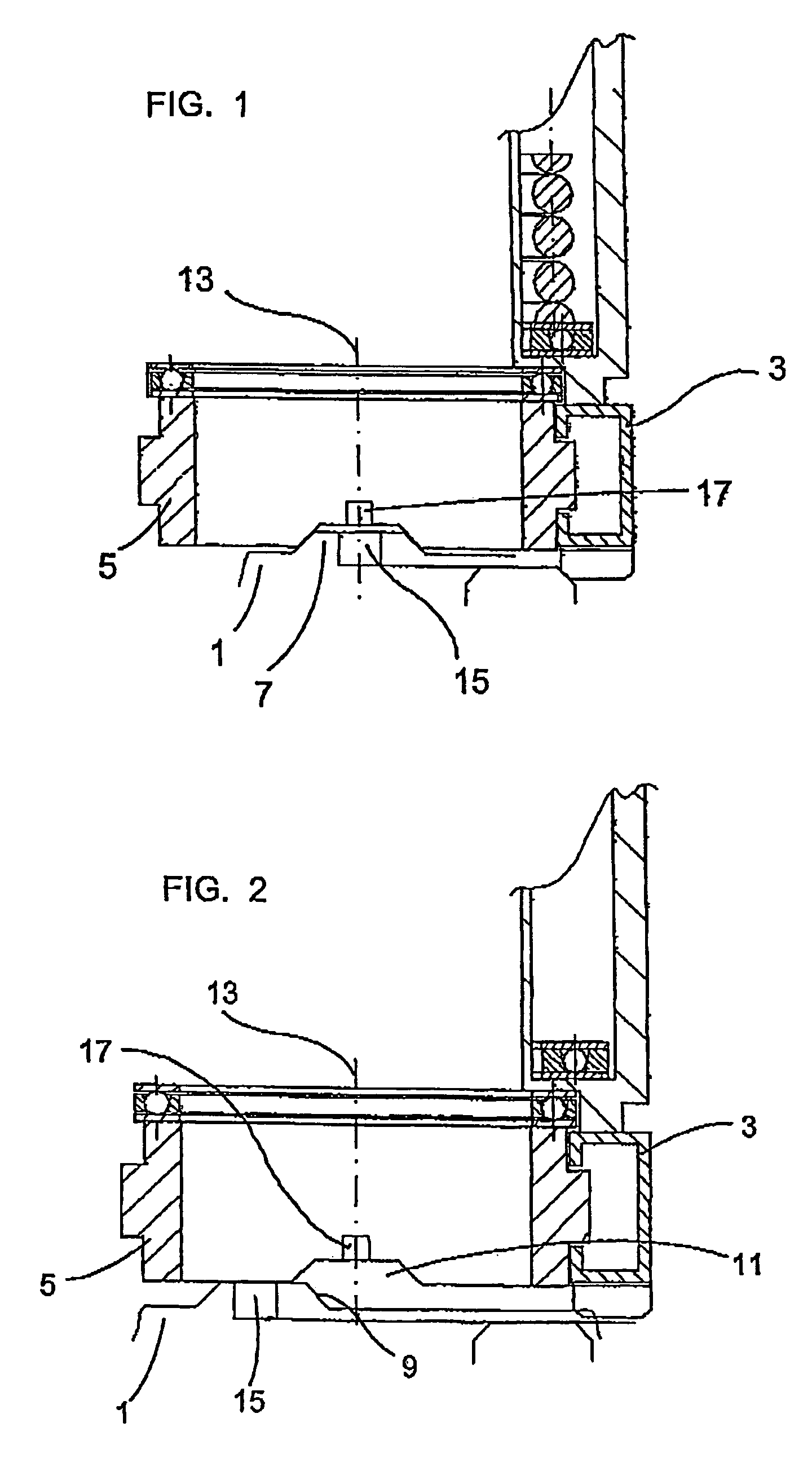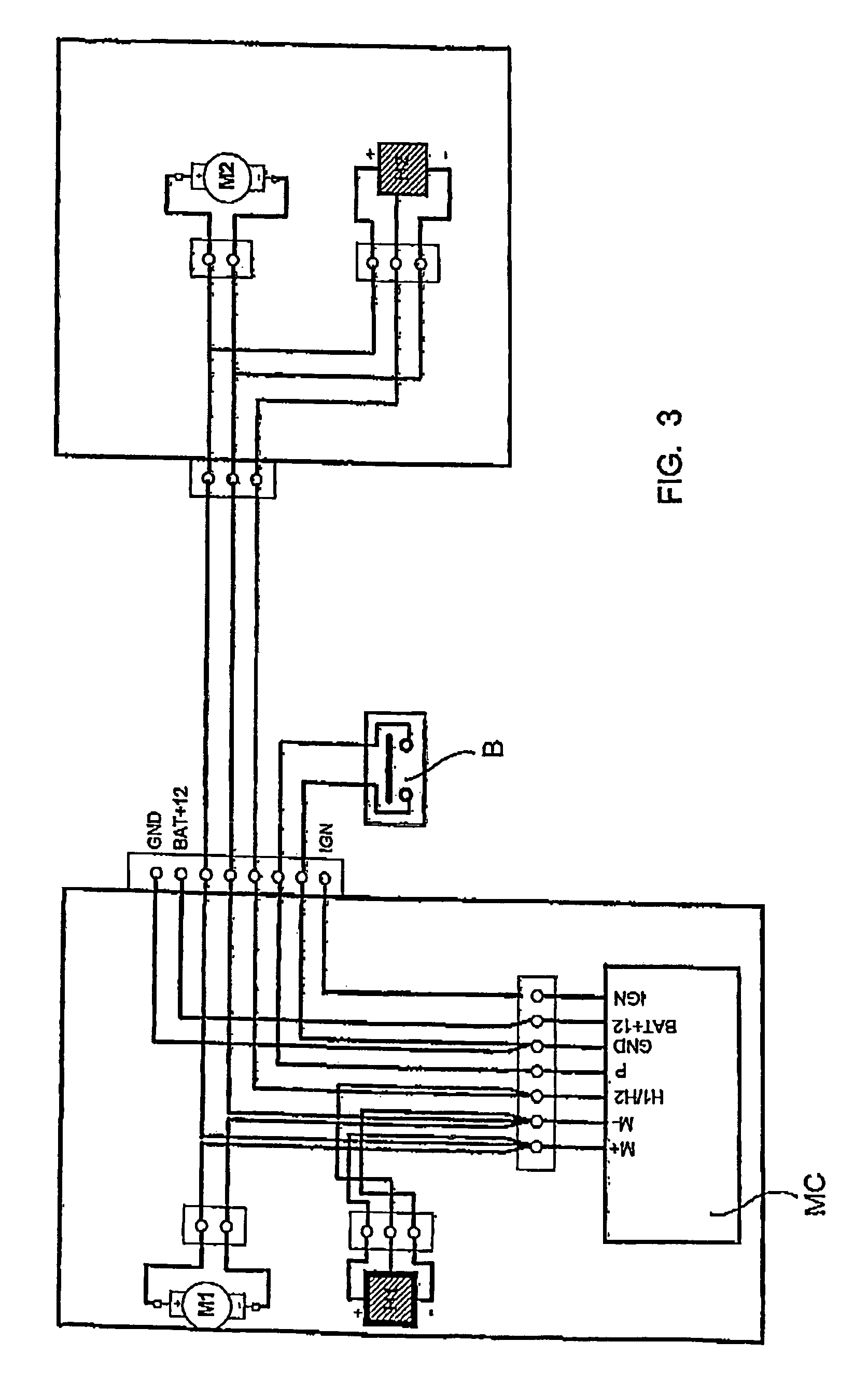[0013]It is possible to provide the
position detector with a plurality of
Hall effect sensors and a plurality of magnets, however, it may be sufficient and logically advantageous, to provide one
Hall effect sensor and one
magnet on each of the meshing points where the meshing point carrying the
Hall effect sensor can mesh. Furthermore, the
magnet may be any type, such as for example an
electromagnet. However, it is particularly advantageous to use a permanent
magnet, which simplifies the construction of the ensemble.
[0014]Another additional
advantage can be achieved by causing the
Hall effect sensor-to be supplied by the two electrical conduits supplying the
electric motor. In this way, the amount of additional electrical conduits is reduced to a minimum, with the subsequent savings in costs and space. A preferred embodiment in this sense consists in supplying the sensor on the basis of electrical impulses having a duration short enough to prevent them from moving the corresponding electric motor but long enough to obtain a reading of the sensor output
signal. In this way, the sensor is activated only during a brief period of time, during which the sensor output
signal is read, and it remains inactivated until a new sensor reading is required. For example, a mechanism in which the reading of the sensor output
signal is taken every 0.5–3 s (preferably every 1.3 s), and where the
electrical impulse lasts approximately 1–1.5 ms (preferably 1.2 ms).
[0016]Flexing mechanisms usually include elements that require electrical power (electric motor, electronic
control circuit,
position detector, etc.). The source of electrical power is preferably the vehicle battery. Advantageously, the flexing mechanism is capable of attaining an activated state directly with the vehicle ignition key, so that when turning said key in the ignition direction corresponding to said engine, which in general usually includes a contact step with the battery and, subsequently, a start-up
motor activation step, said outside rearview mirror is moved from said flexed position to said extended position and upon turning said key in the direction for switching off said motor said outside rearview mirror is moved from said extended position to said flexed position. In this way, the rearview mirror is positioned (between the flexed and extended positions) automatically, without the need for any particular action to be taken by the driver.
[0017]In order to prevent the electric motor from trying to move the rearview mirror or the flexing mechanism to an inaccessible position, in the sense that there is some physical obstacle preventing the desired position from being reached, it is convenient that the electronic control circuit in the flexing mechanism detects the
electric current ramp circulating through the electric motor when it tries to move the rearview mirror but is unable to do so, either because the rearview mirror has reached one of said flexed or extended positions or because there is an obstacle in its path blocking its movement. In this way, the flexed and extended positions of the rearview mirror can be defined by simple mechanical stops and, at the same time, it is possible to prevent any external obstacle from jeopardising the integrity of the motor. Moreover, if the external obstacle is, for example, the driver's finger, or someone else's, they are protected from injuring themselves. Advantageously in these cases, the electronic control circuit interrupts the
electric current supply to the motor according to the values of said current intensity ramp and some threshold values that are a function of the
room temperature and the
battery voltage. In this way, the current intensity fluctuations that must be considered as the result of the variation in
room temperature are taken into account and, as well as therefore the variation in the temperature of the flexing mechanism components.
[0019]Preferably another embodiment of the invention is obtained when the electronic control circuit measures the time taken to perform a movement and compares it with a minimum target time in order to assess whether said movement has made it possible to reach said target position. In this way, the electronic control circuit can determine whether the position reached is the correct one or not.
[0025]Preferably the flexing mechanism comprises a
microcontroller, since in this way the various functions can be carried out more efficiently.
 Login to View More
Login to View More  Login to View More
Login to View More 


